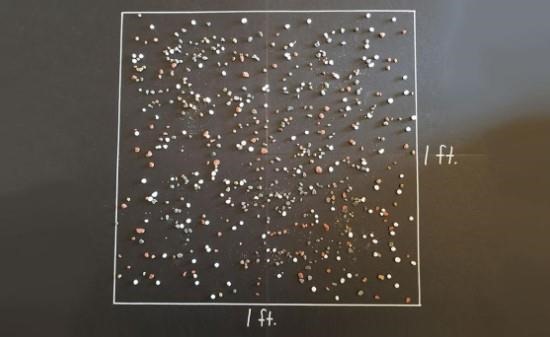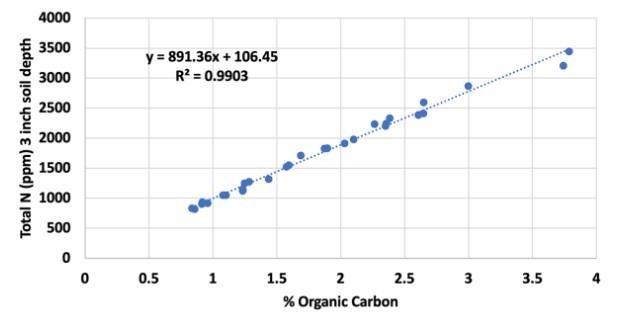By Anthony Bly
When we think of the fertilizer industry, most of us think about large cargo ships, unit trains or large, big-wheeled spreaders full of fertilizer heading to Midwestern corn fields. Have we really asked how much fertilizer is really takes to grow a decent corn crop? By no means am I suggesting everyone should apply the rate I am using in my example. I chose the rate, because over my career as a soils specialist, I have heard a lot of fertilizer rates, and this one seems to be the most representable, especially when it comes down to the N-P-K-S.
Recommended Application Rate

Figure 1. One square foot of soil surface area with fertilizer granules spread across to represent a 140-50-50-20S fertilizer rate (N-P-K-S).
The rate I chose was 140-50-50-20S. Basically, when it comes down to a square foot of soil, this equates to 4 grams of Urea, 1 gram of MAP (mono-ammonium phosphate), 1 gram of potash and 1 gram of AMS (ammonium sulfate). Figure 1 shows the distribution of these fertilizers on 1 square foot. It looks like the 1 ft. by 1 ft. surface is well covered, but when we think about a weight comparison of this 1 square foot to a 3-inch depth volume of soil, there is practically no weight comparison. The weight of this soil is about 21 lbs., or 9,534 grams, and 7 grams of fertilizer is only 0.00000734% of the soil weight. This year the cost of this 7 grams of fertilizer would have been about $190/a or about 0.44 cents per square foot! Wow, not much! So why do we make a big deal about this? A little bit certainly makes a big yield! On the other hand, does it?
To those rightly concerned about the environment, how can 7 grams of fertilizer cause any issues? We know that collectively, this rate applied across millions of acres means so much more. Concentrations of nutrients in run-off water do not have to be much to cause big issues in streams, rivers, pond, lakes and oceans. Therefore, I would like to use this opportunity to introduce you to a developing concept in soil nutrient management called Biological Agronomy. In the past, agronomist focused on inorganic soil tests and fertilizers to optimize crop productivity. In the future, I believe agronomists will eventually focus on organic soil tests and soil biological amendments to harness and build the soil capacity to grow crops on its own with fertilizer additions. Does this sound far out and impossible to you? I want you to consider the following.
“Many are becoming aware how important the role of carbon in soil value and productivity potential. It is a well-proven fact that carbon in the soil holds nutrients and water that are very important to crop and food productivity.”
— Anthony Bly, SDSU Extension Soils Field Specialist
Improving Biological Diversity

Figure 2. Organic carbon and total nitrogen in fields near Mitchell, South Dakota during 2018 (Stehly and Bly, 2018).
Many are becoming aware how important the role of carbon in soil value and productivity potential. It is a well-proven fact that carbon in the soil holds nutrients and water that are very important to crop and food productivity. More carbon = more nutrients and water = more productivity. If we focus our attention on just the carbon and nitrogen, this concept is easier to understand. Science knows that for every 1% carbon in the soil there is about 1000 lbs. of total nitrogen per acre at the 3-inch depth (Figure 2). This nitrogen is mostly in organic forms and not readily available to the plant. Growing this potential nitrogen source and harnessing it with greater biological diversity is the key to Biological Agronomy. Therefore, if we go back to the square foot of soil at a 3-inch depth and investigate how much nitrogen is present, I think we can see potential for the Biological Agronomy approach. The amount of organic nitrogen per square foot of soil 3-inches deep is 21 grams for 2% carbon, 31 grams for 3% carbon, 42 grams for 4% C and 52 grams for 5% C (Table 1). Wow! Compare this to the 4 grams of urea that we applied to the square foot for an optimal corn crop. What is holding us back from wanting to build soil C and N?
TABLE 1. SOIL CARBON AND NITROGEN RELATIONSHIP.
| Soil Organic C A | Carbon | Nitrogen | Carbon | Nitrogen |
|---|
| % | grams/ft.2B | lbs./a C |
| 2 | 191 | 21 | 40,000 | 2,000 |
| 3 | 284 | 31 | 60,000 | 3,000 |
| 4 | 381 | 42 | 80,000 | 4,000 |
| 5 | 477 | 52 | 100,000 | 5,000 |
| 6 | 572 | 63 | 120,000 | 6,000 |
A Soil carbon x 2 = roughly soil organic matter%
B Soil depth = 0-3 inches
C Soil depth = 0-6 inches
Currently, many companies, scientists and, more importantly, farmers are working on this issue, and management solutions are developing every day. So maybe there is a way to get the fertilizer monkey off our back. In the future, it will be good for everyone included. Fossil fuel use will greatly decrease due to reductions in the manufacturing and shipping of fertilizer nutrients, soil health will improve, therefore holding more water and nutrients and less will leak and escape into ecosystems, where they do not belong, and farmers will be more self-sufficient and profitable. Look for an upcoming article discussing Biological Agronomy.
Source : sdstate.edu